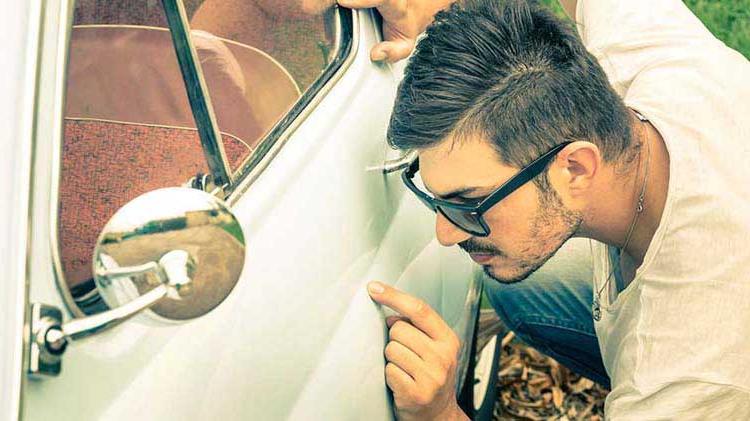Car maintenance tasks you can do yourself
Auto repairs cost drivers $1,118 per year on average, but some can be done at home.
So why not save a few bucks and help retain the resale or trade-in value of your car? Regular engine maintenance and tire pressure adjustments can help keep fuel costs down. And while most auto repairs should be left to the experts, here's a list that are usually do-it-yourself.
Replace windshield wipers
Every six to 12 months is optimal depending on how often they're used. If they leave streaks, make noise or are hard and cracked, it may be time to install a fresh set. Check out WikiHow to learn how, and consult your car's user manual for more information about what type of wipers to buy.
Car paint chip repair
If they aren't too big, a touch-up paint kit might be a good option. Be sure to follow the instructions to get the best results. Popular Mechanics has detailed instructions on how to fix a car paint scratch.
Tire inspection
Tires are your vehicle's contact patch with the ground, and they must be maintained in good condition with proper inflation for the safe and economical operation of your vehicle. Here are a few simple checks you can perform to help keep your tires from letting you down.
- It's a good idea to visually inspect the tires on your vehicle on a monthly basis at minimum. This inspection should note tread depth (in most states less than 2/32 of tread depth is illegal), if the tire is unevenly worn (indicating a potential suspension alignment issue) or if the tire is cracked, damaged or otherwise deteriorated. If any of these conditions are found, you should consult your local tire professional.
- For the correct inflation specification, reference the inflation placard. It's usually located in the vehicle's driver's door jamb area of the vehicle or can be found in the vehicle owner's manual.
- Now that you know the correct inflation specification for the tires on your vehicle, it's time to check the inflation pressure. Inflation should be checked, if possible, in the morning before the car is driven. Tire pressure can change due to many factors, one of which is a change in the ambient air temperature. For every 10 degrees in ambient air temperature change, tire pressure can increase (if temperature rises) or decrease (if the temperature falls) by 1 psi.
Windshield chip repair
Some windshield repairs are covered by insurance. If your windshield has a small chip with minimal to no cracks and you want to fix it yourself, a repair kit may be an option. They generally come with all the materials you need and take about an hour to complete. While it's not possible to fix all chips, you may be able to stop it from growing larger or discoloring in the future. Popular Mechanics discusses the types of damage these kits are recommended for.
Wash and wax your car
One of the best ways to maintain your car's exterior is to remove dirt and residue that can damage the finish. It also provides a close-up look at scratches, chips and dings you may not normally notice.
- Wash the car with a cleaning solution designed for automotive finishes. Work from the top down and use a microfiber washing mitt. Clean tires with a separate bucket of soap and water so you don't get any grease and grime on the rest of your car.
- Inspect the paint for any gunk such as bird droppings, tree sap or pollen. If these contaminants are above the surface, a clay bar designed for car care may help remove them.
- Dry thoroughly with fresh towels. Soft, absorbent waffle-weave microfiber drying towels are a great option. Apply car wax. There are several varieties, but a liquid or paste wax applied every three months will help protect and maintain your car's exterior.
Clean your headlights
Keeping your headlights clean will improve your car's looks and keep you safer on the road. Like brushing your teeth, a little toothbrush and elbow grease will brighten things up. To clean your headlights:
- Tape off the areas around the headlights to protect your paint.
- Apply a little dab of toothpaste on a damp cleaning cloth and rub the toothpaste firmly into the headlight. Add more toothpaste and water as needed for about five minutes per headlight.
- Rinse with water to remove any toothpaste.
- Apply car wax to your headlight after allowing the headlights to dry.
Replace non-headlight bulbs
The light bulbs in the interior and trunk are often easy to replace. To replace them, you'll need to remove the cover by inserting a screwdriver into the slot on the molding and gently wiggle the cover free. After the cover is removed, you can safely remove and replace the old light bulb. Don't forget to place the cover back on.
Ready to tackle more? You can save more money by tackling bigger tasks yourself. Your first step is to make a car maintenance schedule. Once you've made a schedule, you can dive in to bigger repairs such as changing your car's oil and oil filter or replacing the car battery before you get stranded and have to jump start your car. Check out more car maintenance tips to help save you money and keep you safe.



